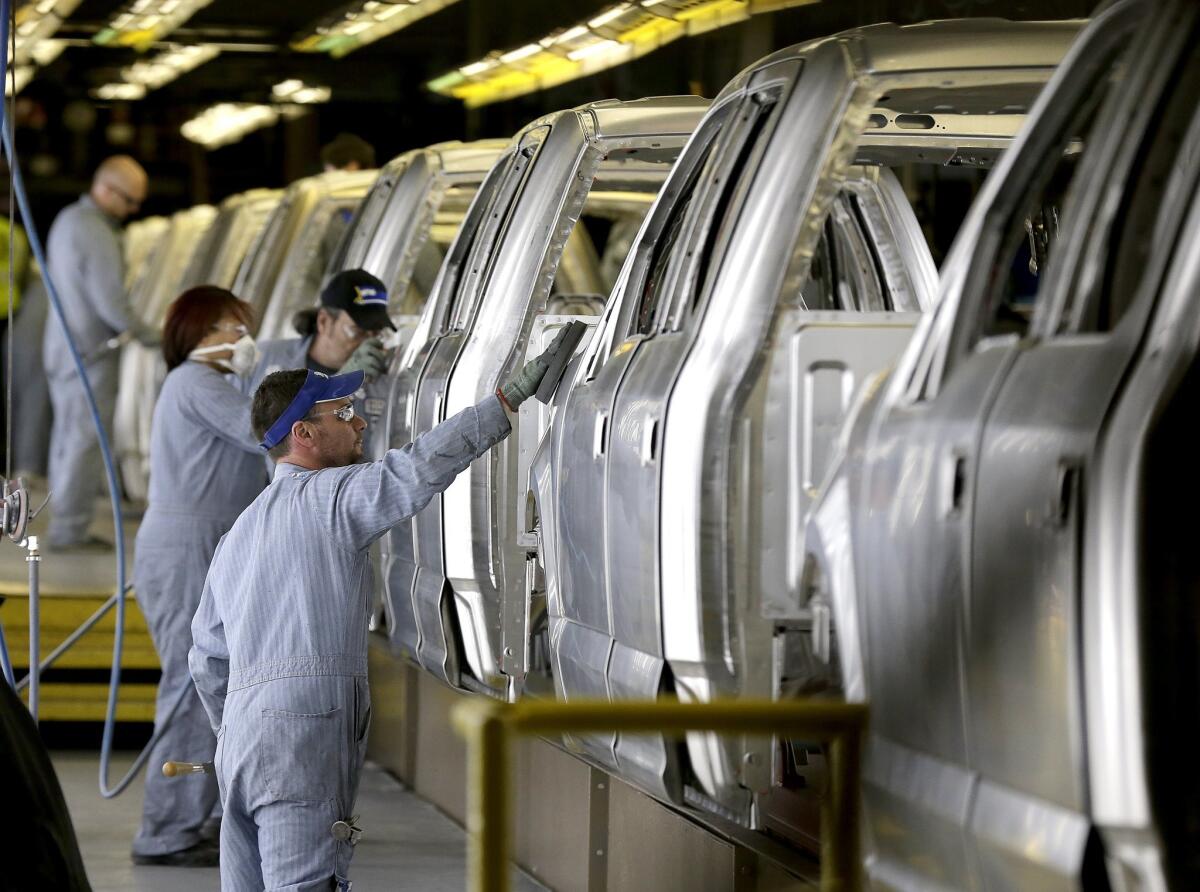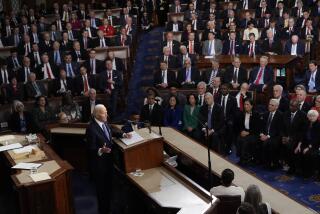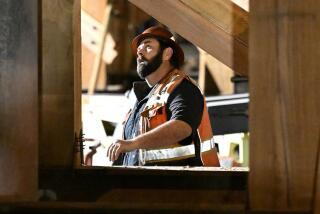Sluggish jobs report raises questions about the direction of U.S. economy

Workers inspect Ford F-150 trucks before they get painted at the company’s Kansas City Assembly Plant in Claycomo, Mo.
For the last two years, America’s job-creation machine has been like “The Little Engine That Could,” chugging ahead with “I think I can, I think I can” regardless of headwinds at home or abroad.
The nation added 3 million jobs in 2014, making up all the ground lost in the Great Recession, and then piled on another 2.7 million jobs last year. All while the broader economy, as measured by the gross domestic product, grew at a relatively lackluster pace.
But the January jobs report, released Friday, suggests that the ever-dependable locomotive for the U.S. economy has encountered a hill that slowed it sharply.
The question now is whether it is just moving through an unusually steep patch or has finally met a hill it cannot conquer. The answer probably won’t be known for a couple of months, but Friday’s report has further clouded the outlook for investors and the Federal Reserve’s interest rate policy.
The Labor Department said that employers added just 151,000 jobs last month, down from an average monthly gain of 283,000 in the fourth quarter of last year.
Economists caution that one can’t make too much of a single month’s data, especially in the winter when weather can skew payroll statistics. Unseasonably warm temperatures in December probably inflated hiring that month in construction, for example.
Besides, just over 150,000 new jobs should be more than enough to absorb growth in the workforce. And January’s gains, while below expectations, still nudged the unemployment rate to 4.9%, the lowest in eight years.
Also, there was encouraging news for many who have jobs: Average hourly wages picked up at the start of this year, to a 2.5% annual growth rate, as the supply of available workers tightened. Some of that reflected a bump up in the minimum wage in a number of states and localities, affecting about 4.6 million workers.
President Obama, commenting on the economy Friday at a press briefing, did not mention the job-growth slowdown in January but instead highlighted the continuing drop in the jobless rate, from 10% in 2009, and how that was now translating into bigger paychecks for workers.
“Over the past six months, wages have grown at their fastest rate since the crisis,” the president said. He promoted his upcoming budget proposal, arguing that it would “offer more opportunities for Americans to get the education and training they need for a good-paying job.”
Looking at the job market in the context of the whole economy, it is probably true, as Labor Secretary Thomas E. Perez said, that the closer the economy comes to the summit of full employment, the steeper the climb to create new jobs.
“A slowdown in the quantity of jobs created coupled with wage increases” is what one would expect, he said in an interview Friday. “People are finally starting to get a raise after literally years of wage stagnation.”
Important as all those potentially positive factors may be, the drop-off in job growth was well below analysts’ forecast of 190,000. And the slowdown comes at a time of mounting worries about whether the American economy can continue to withstand a host of other pressures:
From China and Japan to Western Europe to Brazil and South Africa, the global economy is slumping. A strong dollar is making U.S. products more expensive for overseas buyers. Depressed commodity prices, including oil, may be helping consumers, but they have hurt U.S. corporate earnings, stock markets and manufacturing.
“The job market has hit an inflection point downshifting to slower gains,” said Sung Won Sohn, a former White House and bank economist who tracks the economy from Cal State Channel Islands.
He said it was too early to tell whether hiring would falter, but noted that up until now, the sturdy job market had been the exception while other economic indicators had been flashing warning signs, especially American industrial production.
“That’s what we’ve been hanging our hats on,” he said of the labor market. And so has the Fed, he said, adding that the central bank should hold off in raising rates at its next meeting in March.
Already, Sohn and other economists, who began the year forecasting GDP growth of 2.5% or higher for 2016, have ratcheted back projections to 2% or less, also in part because of tighter credit conditions and an undesirable buildup of inventory. Many economists also have raised their odds for recession, although they remain fairly low for now.
“If employment goes, then confidence in the economy is shaken,” Sohn said.
Other economists were more optimistic about Friday’s employment data. Besides rising wages, they noted that the household-survey part of the report showed increases in the percentages of the working-age population that is employed as well as those participating in the labor force. Those shares remain low by historical standards, but have recently started to inch up.
“The household survey confirms the underlying health of the labor market,” said Sophia Koropeckyj, a labor economist at Moody’s Analytics. “The labor market is quickly approaching full employment with the unemployment rate falling below 5%,” she wrote in a research note to clients. “Fewer workers lost their jobs and the number working part time involuntarily has come down.”
The January payroll job numbers were not as encouraging.
Two-thirds of the 151,000 net job increases last month came from two industries — retailers and restaurants. Both pay relatively low wages, although the rapid growth at food services has helped lower the Latino unemployment rate nationally to 5.9% in January, the lowest since late 2007. Latinos make up 16% of the total workforce but account for 25% of the food services industry, said the National Council of La Raza.
U.S. manufacturing added a surprisingly strong 29,000 jobs, despite declining production indications in the last four months.
One big weakness in hiring last month, however, came in the sprawling business and professional services, which includes high-paying technical jobs such as engineering and computer systems design. The sector added a small 9,000 jobs after increasing a net 60,000 staff in December. Temporary-help firms, traditionally seen as a harbinger of broader hiring, lost 25,000 jobs last month, erasing all of the gains in the prior month.
In addition, private educational services, which have been hard hit from scrutiny over high student loan defaults, shed jobs last month, as did the transportation and warehousing sector and the oil and related mining industry.
Paul Ashworth, an economist at Capital Economics, indicated that the labor market is stronger than the job-growth decline might suggest. Still, he described Friday’s report as mixed, saying that “is another reason to suspect that the Fed will stand pat until at least the middle of this year while it waits to see how economic conditions develop.”
Follow me on Twitter @dleelatimes
MORE FROM BUSINESS
Why your Super Bowl vegetable platter might cost more this year
Review: 2016 Prius Four is a smarter, sleeker version of Toyota’s aging hybrid
Hiltzik: How a huge insurance company screwed up on Obamacare







